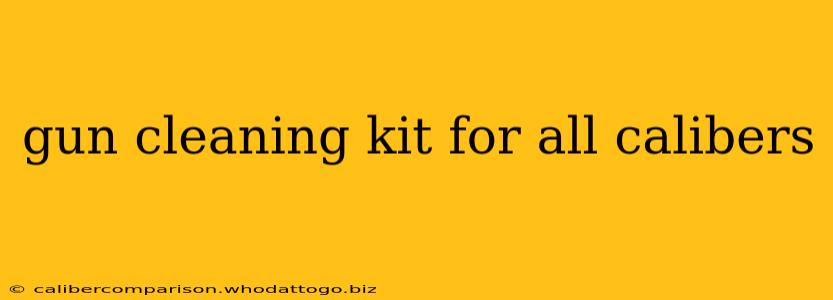Maintaining your firearms is crucial for their longevity, accuracy, and safety. A well-stocked gun cleaning kit is an essential investment for any responsible gun owner, regardless of caliber. This guide will walk you through assembling the ultimate gun cleaning kit capable of handling virtually any firearm you own. We'll delve into the essential components, explain why certain tools are necessary, and provide tips for proper cleaning techniques.
Essential Components of an All-Caliber Gun Cleaning Kit
While numerous kits are available, assembling your own allows for customization based on your specific needs and firearm collection. Here are the essential components:
1. Cleaning Rods:
- Material: Choose high-quality rods made of bronze, stainless steel, or carbon fiber. Avoid using steel rods on firearms with chrome-plated or delicate barrels. Consider having multiple rod lengths to accommodate different firearm lengths.
- Sections: Modular rods are preferred. These allow you to adjust the length, preventing bending and damage to your firearm.
2. Cleaning Patches:
- Material: Use patches made of high-quality cotton or flannel. Avoid using abrasive materials that can scratch the barrel.
- Sizes: Stock a variety of patch sizes to fit different caliber bores. Pre-cut patches are convenient, but you can also cut your own from suitable fabric.
3. Bore Brushes:
- Material: Bronze bore brushes are generally preferred for their effectiveness and gentleness on the barrel. Nylon brushes can be used for a more gentle cleaning.
- Caliber Specific: You'll need a bore brush for each caliber you own. Don't compromise on this; using the wrong size brush can damage your firearm.
4. Gun Cleaning Solvent:
- Type: Select a high-quality solvent designed for removing fouling and residue from various calibers. Choose a solvent that's safe for your firearm's materials.
- Non-Flammable: Opt for a non-flammable solvent for safety reasons.
5. Gun Oil:
- Type: Use a high-quality gun oil specifically designed for firearms. This oil lubricates moving parts and prevents rust and corrosion.
- Application: Apply sparingly to prevent excess buildup.
6. Cleaning Patches (Additional):
- Quantity: You'll need a significant quantity of patches for each caliber, as you'll be using multiple patches throughout the cleaning process to remove residue.
7. A Cleaning Mat:
- Purpose: Use a dedicated mat to protect your firearm and surfaces from solvents and gun oil.
8. Slotted Tip:
- Purpose: Essential for attaching your patches securely to the cleaning rod. This helps avoid accidents during cleaning.
9. Jag:
- Purpose: Attaches cleaning patches and brushes to the cleaning rod, particularly for smaller caliber firearms.
Beyond the Basics: Optional but Valuable Additions
- Chamber Brush: This brush is specifically designed to clean the chamber of your firearm, removing any built-up residue.
- Breech-to-Muzzle Cleaning Kit: These kits make cleaning easier for firearms with difficult-to-access areas.
- Cleaning Kit Case: A dedicated case keeps everything organized and protects your tools.
Safe Gun Cleaning Practices
Always follow these safety precautions when cleaning your firearm:
- Unloaded Weapon: Always ensure your firearm is completely unloaded and clear of ammunition before you begin cleaning. Visually inspect and confirm this.
- Proper Ventilation: Clean your firearms in a well-ventilated area, away from open flames. Solvent fumes can be hazardous.
- Eye Protection: Wear safety glasses to prevent accidental injury from flying debris or solvent splashes.
- Gloves: Wear gloves to protect your hands from solvents and protect your firearm from oils and dirt from your hands.
By assembling a comprehensive kit and following proper safety practices, you can keep your firearms in top condition for years to come. Remember, regular cleaning is crucial for maintaining accuracy, reliability, and the overall lifespan of your firearms. This guide ensures you have all the tools and information to confidently and safely clean any caliber.

